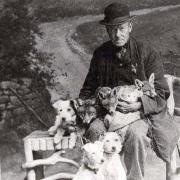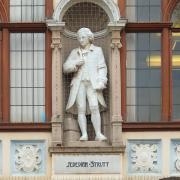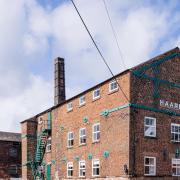Derbyshire Life meets the members of Spondon Archive on the publication of their latest book

When I’m planning a village article for Derbyshire Life, it’s made easier if some village history has been recorded. At the least, I’m usually handed a pamphlet about the parish church. Ideally, there will be a slim booklet with a pocket history of the place. Occasionally, I am given books that would make a feature on their own, like Crich Tales, chock-full of local characters and their juicy reminiscences.
The finest village book I have come across is Quarndon Then & Now, 230 pages packed with historical revelation, information and insight, assembled over 22 years by the late Bryan Harris. On publication in 2008, the Revd William Bates of St Paul’s in the village, wrote: ‘As the book stimulates interest in Quarndon, it has the potential to become, in itself, a symbol of community.’
However, no village in Derbyshire – and possibly in Britain – can match Spondon. This village’s symbol of community is not a book but a group: Spondon Archive, the publishing name of Spondon Community Association and Spondon Historical Society.
Since 2011 Spondon Archive has published two books a year, a fine testament to a group of volunteers for whom this task has become a labour of love. Fittingly, the Archive was founded following a meeting of the Spondon Village Improvement Committee. As Anita Hayes recounts: ‘2011 was a significant year in the history of some of our local organisations and we thought we should make an effort to record this. We started collecting short written histories and photographs from the organisations and soon had enough for a book.’

That initial publication was Spondon Clubs & Societies. Before they knew it, a second book was proposed and soon published: Anita’s husband David had already researched the history of the Grade II listed Malt Shovel pub. The Spondon Archive was up and running.
A diverse range of books has followed: separate histories of Spondon Parish Church and its Methodist Church; two volumes of Spondon School history; a book on Transport in Spondon through the ages entitled Canoes to Commuters; Spondon Goes to the Pictures; and Exploring Spondon, various walks through the village’s history.
There are rich pickings in every book. For example: The Parish Church of St Werburgh notes that in medieval times, there were no seats in churches so the congregation had to stand in the nave; The Methodist Church, Spondon reveals that the founder of Methodism, John Wesley, was said to have preached from the steps of 31 Moor Street in Spondon; Canoes to Commuters records that in 1938 the village railway station was awash with so many workers at Celanese that the timetable listed 22 daily trains from Derby and 20 from Nottingham; in Spondon Goes to the Pictures, the official opening of the Sitwell Cinema was very controversial with the Spondon Rural District Council chairman declaring that many villagers regretted the advent of the cinema because it might ‘do away’ with simple village life and Lady Fowler, who opened the building, announced that she didn’t like the idea of a cinema but supposed it was a ‘necessary evil’; Spondon School 1839-1964 tells of the ‘wide belief’ that a Hungarian teacher at the school in the 1960s, Eugene Kenedy – who compiled that history – was involved in espionage for British Intelligence during World War II. Interestingly, he was a renowned marksman and versed in martial arts, so perhaps Spondon had the Magyar version of James Bond!
The latest Spondon Archive book is a vivid, revealing and occasionally racy personal memoir chronicling over 80 years of the life of Spondonian Frank Hooley, 1889–1975. His was a life well lived, from the time he was in infant school and feared the Headmaster, ‘a real tartar’ who had a four foot long cane that he used ‘like a Frenchman using a rapier.’
Frank recalls rum characters like Lumpy Shay and Charlie Pears, both poachers, and an old washer lady, Nancy Dawson, who young Frank thought was a witch because ‘she had no teeth and her long nose nearly touched her chin.’
Saturdays in turn-of-the-century Spondon were extraordinary: a German Band awakened the village as early as seven o’clock though, as Frank reveals, the pubs were open from six in the morning. The band was soon followed by the organ grinder with his monkey, a Russian with a dancing bear, and a man selling fly papers who wore an old top hat with fly paper around the crown, encrusted with hundreds of dead flies.
Refreshingly, Frank’s cheery demeanour makes World War I seem more like a jaunt than a slaughter, even though he writes about the trenches where it was ‘mud up to our boot tops.’ He also recalls ‘dodging shells’ and being ‘a bit crushed’ by a direct hit in his dugout, but his choicest memories are of jokes, japes and the time he befriended a flag seller near his barracks, a married woman who slept with him when her husband was away. As Frank recalls: ‘She said that she would never have thought that selling me a flag would bring so much fun.’
And who would have thought after publishing its first book in 2011 that Spondon Archive is now publishing its tenth? It’s a remarkable success story, and also one that provides a perfect template for any village considering a similar project.
Ideally, Spondon already had a historical society which made them a ‘natural partner’ to work with the Improvement Committee. Currently, Spondon Archive is made up of people from both groups.
As Anita explains, ‘As well as needing a committee structure, you should ideally have a group of enthusiasts with the ability to research, work together and write. Crucially, you must also accept corrections and criticisms, especially of punctuation.’
You must be prepared to invest a lot of your time, too, advises Derek Hathaway. He should know: he spent over two years chasing the copyright on the history of Spondon School.
An obvious though often overlooked consideration is whether your book will sell. Clearly, Spondon Archive has a strong record: out of 3,050 Spondon Archive books printed over these five years, an impressive 2,500 have been sold.
There is the further consideration of funding. ‘If you can’t sell your first book, you won’t be able to fund the next one,’ declares Anita. The cost of publishing 500 copies of the Archive’s initial book on village clubs and societies was nearly £1,000. After the first two print runs of 500 each, the Archive reduced the number of copies to 250 and, having set the price of each copy at £2.50, they have now increased it to a still affordable £3.50.
What is especially impressive about Spondon Archive is that right from the start it was run like a professional publishing house. For instance, each book has an ISBN and thus copies are sent to the British Library and the other five legal deposit libraries. Furthermore, a Style Guide was produced so that each book has a house style with continuity of layout, fonts, punctuation, cover design – created by Steve Allen who runs Spondon Online – reliable printer – Eight Days a Week Print Solutions, based in Nottingham – and, crucially, sales points – three local shops sell the books, free of charge. Also, the books are advertised on local websites and this brings in orders from other parts of the UK and even abroad.
One final piece of practical advice from the Archive team is: proof read, again and again and again… ‘It must be done,’ says Anita; ‘everyone in our group reads all the books two or three times during the production process. If you have written it yourself, you have probably read it 20 times before printing so that you never want to see it again… except when it’s printed and on sale, of course, and you get a real buzz… until you spot the apostrophe in the wrong place!
Already underway is the 11th book – on Spondon Scout Group – with planned publications about Spondon’s pubs, War Memorials, a ‘Then & Now’ book of photos and, hopefully following the Scout book, a history of the early years of British Celanese.
As Derek Hathaway believes, the Archive books have galvanised the village: ‘What sets Spondon apart from other suburbs of Derby is its sense of community and identity. An important contributor to that is sharing the history of the village with current residents, ex-residents, and their families; and as our series of books have explored many fascinating facets of Spondon’s past, we have thus enlightened and enlivened this community. As we publish more – and we’re now looking at increasing production to three books a year – that sense of community and identity can only get better.’
My Life in Spondon and other great places is available now – price £3.50 – from Spondon Hardware, Housley Pharmacy and Spondon News in Spondon, along with the other nine books in the series.
Books can also be ordered through Spondon Historical Society website: spondonhistory.org.uk



























